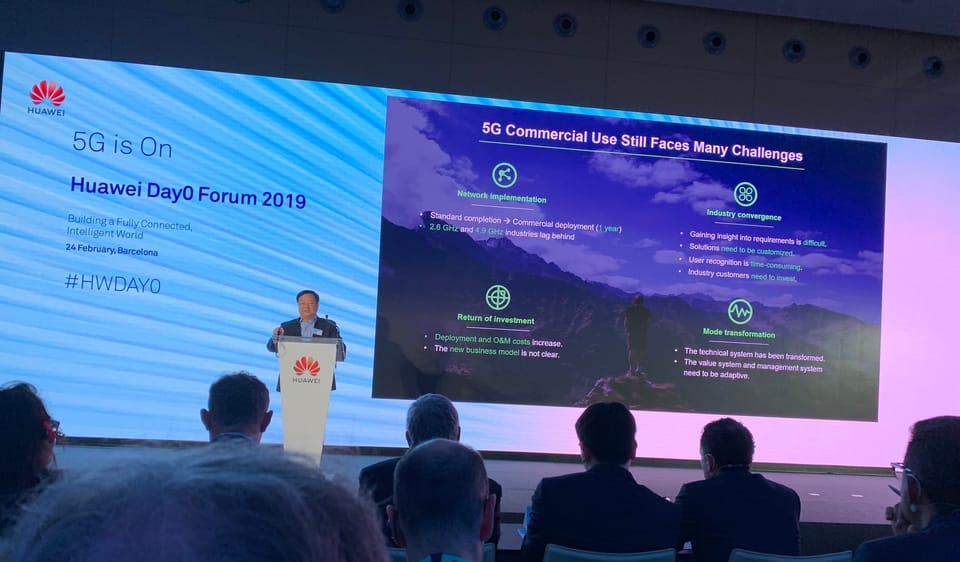New Zealand telecoms after Huawei

Higher costs main impact as NZ telcos moved on from Huawei
Six years ago Chinese equipment maker Huawei was confident it would build at least one of New Zealand’s 5G mobile networks.
The prospects looked good. Huawei had previously built Spark’s 4G network and had been 2degrees’ main technology partner for a decade. Spark CEO Simon Moutter had already gone public with his company’s decision to use Huawei kit to upgrade its network.
TICSA standards
Officially that was because Huawei did not meet the standard set out in the Telecommunications (Interception Capability and Security) Act 2013, this is known as the TICSA.
The National Cyber Security Centre, which is part of the GCSB and ultimately embedded in the New Zealand Intelligence Community, says the goal is to make sure “that any changes to our telecommunications network infrastructure, which underpins the operation of many other critical infrastructure sectors, do not create network security risks”.
Over the last decade, TICSA has been the agency’s key tool for doing this. As the NCSC says:
The TICSA has proven to be an effective mechanism for identifying risks associated with telecommunications network changes, including the incorporation of new equipment. Selecting vendors is a commercial decision for telecommunications network operators, subject to compliance with TICSA.
Under Part 3 of the Telecommunications (Interception Capability and Security) Act 2013 (TICSA), the GCSB works with network operators to identify and address risks to the security of New Zealand’s public telecommunications networks, arising from the design, build or operation and their interconnection to other networks both domestically and overseas.
TICSA applies a country- and vendor-agnostic approach. It takes a case-by-case approach to the use-case involved in each notification. New Zealand has not banned any vendor.
It’s also important to recognise that vulnerabilities can come from multiple sources, ranging from the supply chain through to operator and user practices.
Smart political manoeuvres
However it was arrived at, and there are no reasons to suspect anything other than the agencies working through the TICSA process, the GCSB decision gave the government and Andrew Little, who was the minister responsible for the GCSB at the time, a convenient out.
At a time when other nations were banning Huawei from networks, New Zealand could simply point at the company’s failure to meet a regulatory standard. It was a politically smart move.
It also marked a massive change in direction for New Zealand telecommunications which has become increasingly entwined with Huawei. When, a few years earlier, John Key was prime minister, he praised the company on a number of occasions and made it clear Huawei was a preferred partner for key projects.
Huawei was, and remains, a huge Chinese business with close ties to the Chinese government. That makes western governments uneasy.
Spying claims
At the time these decisions were made, there were well publicised claims in media everywhere that Huawei either was already involved in spying on behalf of the Chinese government or could potentially start spying at any moment. To date, nothing has been proved, or if it has, the governments concerned have kept quiet about it.
That’s not to say there were no issues. Huawei dominated a strategic market at a time of rising tensions between China and the west. Even if there was no potential for spying and no secret ‘kill switch’ able to remotely shut networks down, there was still the risk of depending on an increasingly hostile nation to supply a key technology.
As a result of these global restrictions, Huawei has made a significant strategic move, seeking to build out a powerful presence in the enterprise cloud market as its next major focus.
Today there are still small pockets of ageing Huawei equipment in the nation’s telecommunications infrastructure. These are not controversial and, no doubt, will be swapped out in due course.
Carriers still distancing from Huawei
Spark says it first deployed Huawei radio equipment for the 3G and 4G networks in 2013, and is currently in the process of swapping all Huawei equipment out to its new 5G and 4G radio vendors, Nokia and Samsung.
The company says: “Our 5G network rollout (including the build of our 5G core) which is currently underway, does not include any Huawei equipment. Our upcoming 3G network shutdown will also include the removal of Huawei ’s 3G RAN equipment from our network”.
It’s much the same at 2degrees which says: “We have some Huawei equipment in our network but we are moving to Ericsson and other vendors as part of our network modernisation programme of work which is well progressed”.
Lower impact at One New Zealand
One New Zealand has always had less exposure to Huawei than Spark or 2degrees. The company says: “One NZ doesn’t use Huawei equipment in our mobile access or mobile core networks. Instead we have a long-standing partnership with Nokia to provide 2G, 3G, 4G and 5G for our customers.
“We have minimal Huawei networking equipment remaining in our legacy fixed network, and it is our intention to replace or retire all Huawei kit over time. We have no supply or support contracts in place with Huawei or any other Chinese manufacturers and support it with internal resources.”
Like the other telcos, One NZ sometimes uses third party networks, including the nation’s fibre companies, which may or may not include some Huawei kit.
Customers still have Huawei kit
Tens of thousands of homes and premises will have Huawei routers and other customer equipment. Again, these devices will be replaced at the next upgrade. There will also be Huawei mobile phone handsets, laptops and tablets out there in the wild.
One NZ says: “Some customers use Huawei devices and handsets, for example our 4G fixed wireless access modem. Government security agencies have not provided any guidance or direction that use of these devices create a security issue, and we believe the use of these end-user devices presents no additional security risk compared with any other brand of device."
There is a cost
Speaking anonymously, a senior telecommunications executive told me the consequences of Huawei being shut out of New Zealand’s telecommunications equipment market are almost entirely financial.
Taking a large, competitive supplier out of the market means carriers pay considerably more for network equipment.
One way or another, this extra cost is passed onto customers. The price of a 5G plan could be a little more expensive. At the same time, stretched budgets may have led carriers to roll out networks at a slower pace. The higher cost may have affected carriers’ profits.
On a positive note, New Zealand does not appear to be missing out any great technologies Huawei supplies to its remaining customers.
Spark appoints digital equity lead
Spark has promoted Martin La’a to become the company’s first digital equity lead. The company established the new role so there is a single leader for its projects in digital access, skills training and wellbeing. It covers the Spark Foundation, Skinny Jump and the company’s Te Awe skills hub.
La’a is currently in charge of Te Awe. Spark Foundation lead, Kate Thomas, will leave the company at the end of the month and La’a moves to his new role on September 1.
Spark says the Spark Foundation will continue to operate as a separate charitable trust. Te Awe and not for profit broadband product Skinny Jump will remain independent of the Foundation and continue to operate within Spark as they do today.
Leela Ashford, Spark’s sustainability director, says organising all the company’s digital equity projects under a single leader will maximise the impact and “connect the dots between access, building a diverse talent pipeline in the community, bringing those skills into the sector with care, and then continuing to evolve capability over time.”
Public cloud service spending to double in four years
IDC says the world will spend US$805 billion on public cloud services this year and the total spend will double by 2028. The research company says the growth will be spread across all industry and service types.
Cloud now dominates tech spending. Eileen Smith, a group vice president at IDC says: "Most organisations have adopted the public cloud as a cost-effective platform for hosting enterprise applications and for developing and deploying customer-facing solutions.”
Banking, Software and Information Services, and Retail are the three largest spenders accounting for $190 billion, close to a quarter of the total. The next five industries; Telecommunications, Media and Entertainment, Capital Markets, Healthcare Provider, and Professional and Personal Services, each account for more than 5 per cent of spending.
IDC says artificial intelligence is the main growth driver for public cloud. Meanwhile, other IDC research on AI says phones with generative AI functionality will account for 19 per cent of the market this year and will be 70 per cent of the market by 2028.
In other news...
‘Super highway’ in planning
Datagrid chief executive Perrine Dhalluin revealed more about plans for the The Te Waipounamu data cable in an interview with The Otago Daily Times’ Toni McDonald.
The company will be establishing the subsea cable in conjunction with its Makarewa data centre site.
It is hoped the new cable, with a cost about $160million, will be commissioned by 2026.
The cable will span 3000km between Invercargill and Australia — connecting directly to both Melbourne and Sydney, allowing data to transfer at 120 terabits per second.
Later in the story Dhalluin talks about a 35 per cent improvement in latency to Australia for users in Southland and Otago.

Optical fibres fit for the age of quantum computing
Going beyond Hyperfibre, researchers at the University of Bath have developed a new generation of optical fibre capable of dealing with the demanding data transfer needs of quantum computing.
The optical fibre used in today’s networks transmit light at wavelengths which makes sense for telecommunications applications, but do not work well with the single-photon sources, qubits and components needed for quantum technologies.
Bath University’s new quantum-ready fibres have a micro-structured core, featuring a complex pattern of air pockets. This makes them better at manipulating quantum light properties and supporting quantum technologies.
New player Kiwi Mobile offers $1.30 per day plan
Chris Keall looks at a new MVNO for the NZ Herald and mentions the lack of impact this sector has made so far in New Zealand.
Asia's regional internet registry APNIC names new director general
The Register’s story from Simon Starwood reveals that “ICANN's local boss Jia Rong Low gets the gig”.
SouthPAN uplink processing centre opens in NZ’s Southland (no link)
CommsDay’s Dylan Bushell-Embling covers the opening of a satellite uplink centre at Awarua in Southland which is part of the Southern Positioning Augmentation Network or SouthPAN.
He writes:
SouthPAN is a joint initiative of Land Information New Zealand and Geoscience Australia. The project aims to improve the accuracy of positioning systems in Australia and New Zealand from 5-10m to less than 1m, and in some cases to as little as 10cm.
Multiple service providers affected by fresh NZ Microsoft outages
It’s been a tough couple of weeks for Microsoft customers. On Wednesday I posted: Ironically risk-averse thinking deepened the CrowdStrike fiasco then on Thursday Rob O’Neill reported at Reseller News:
After resolving global outages to its cloud services on 31 July, multiple local end users and service providers experienced fresh, NZ-specific downtime this morning.
On X, Microsoft told users it was investigating reports of access issues with Microsoft 365 services, including Exchange Online, for users in New Zealand.
“We’ve rerouted network traffic to alternate infrastructure and are seeing improvements in service ability,” the company said in an early update.
Customers of Spark, 2degrees and Datacom among others faced issues of access to Microsoft cloud services including Outlook and Teams.
The local problems affected me as I was interviewing a contact for a newspaper story on Teams at the time and wondered, incorrectly it turns out, if there were problems with the fibre connection.
Member discussion